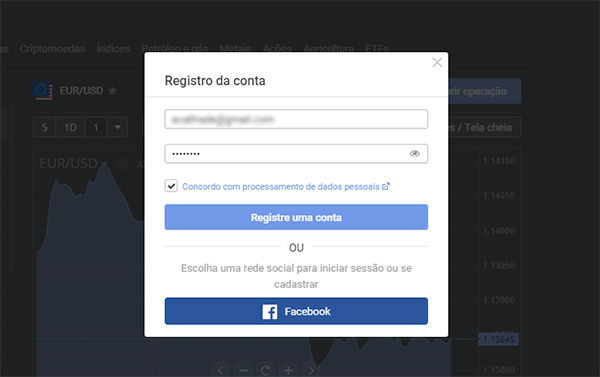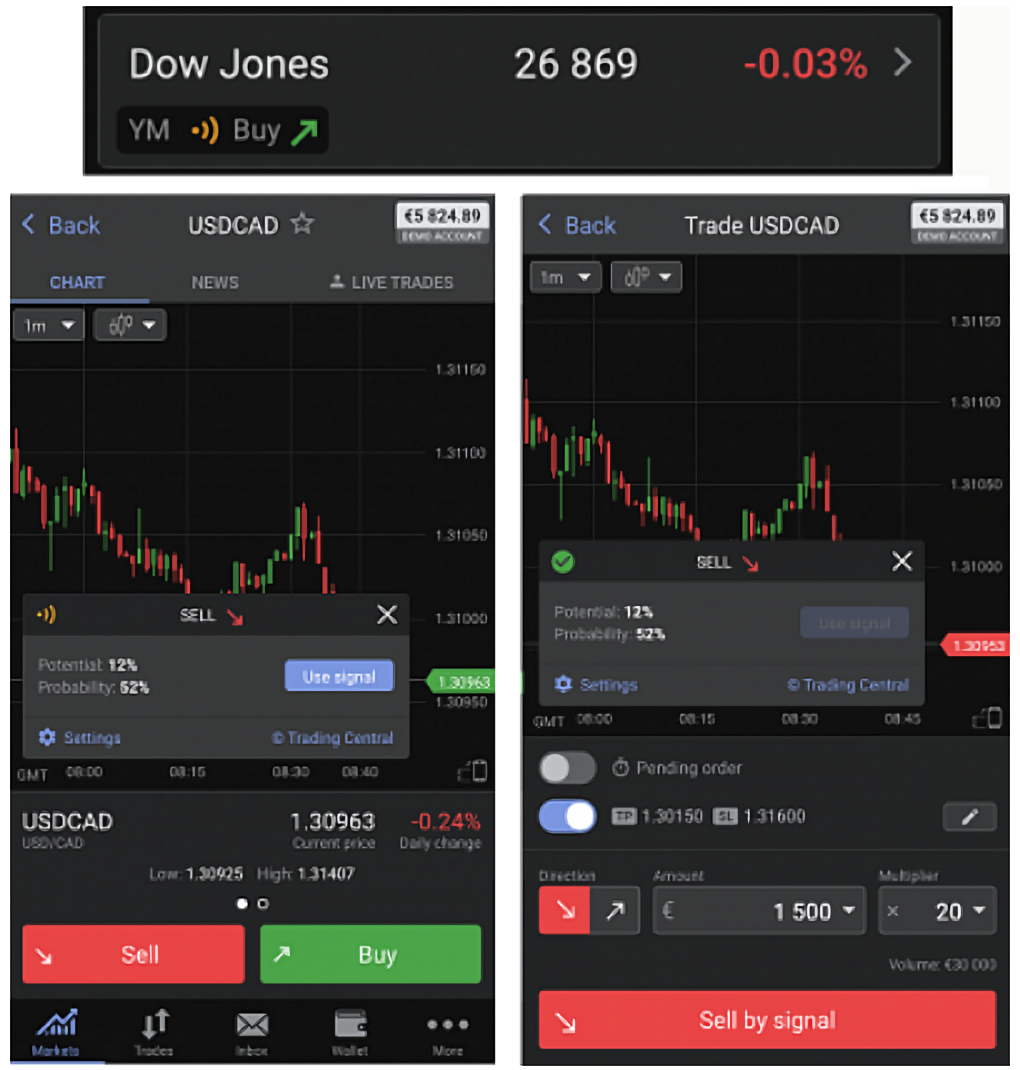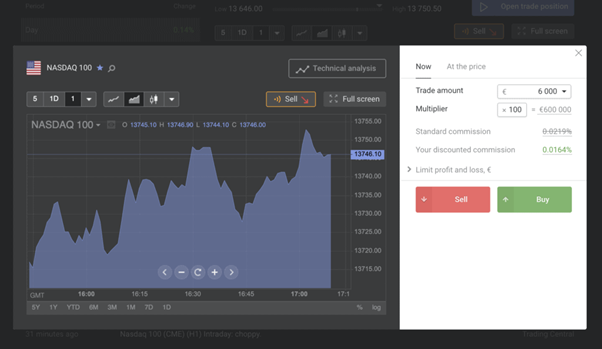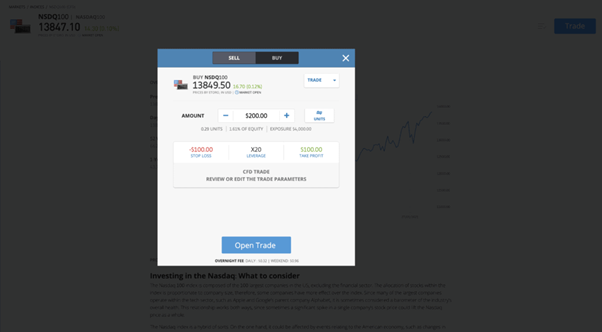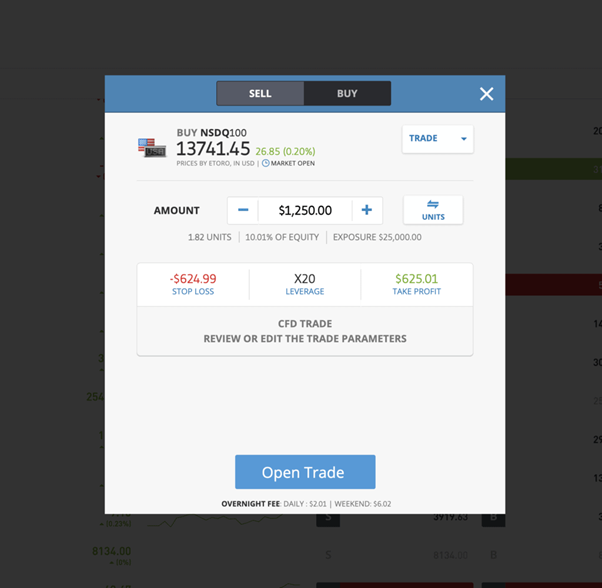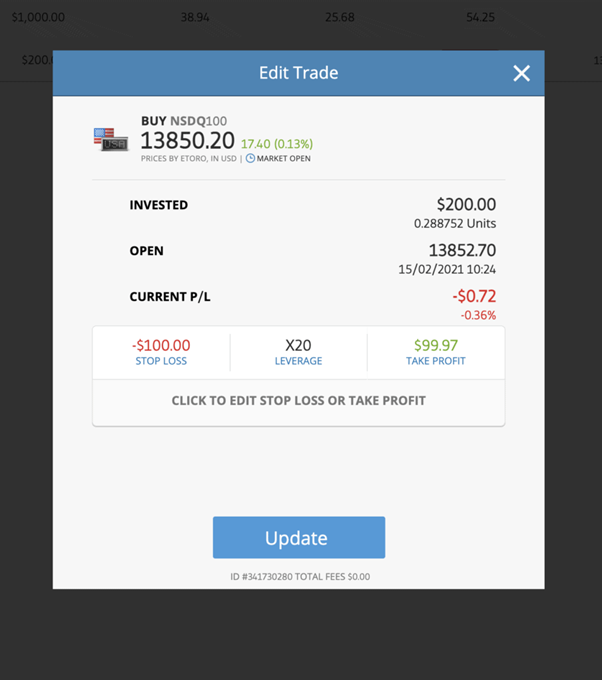Como Fazer Trading de Índices Bolsistas em Portugal – Guia para Iniciantes
In this guide, we will explain the essential concepts of how to invest in indices and the reasons that make this type of investment a quick and cost-effective way to gain exposure to a variety of different companies.
Finally, we have selected the best platforms for investing in indices for new investors, and how to set up your account and first trade.
How to Invest in Indices
85% das contas de investidores de varejo perdem dinheiro ao negociar CFDs com este provedor.
[side_by_side_comparison id=”18″ type=”Crypto”]
How to Invest in Indices in Portugal – Step by Step Guide

It also offers an accessible mobile app and website, as well as commission-free trading and a wide range of analysis tools.
Step 1: Open an account with Libertex
We would like to emphasize again that Libertex is an authorized and regulated broker by the FCA.
This means that it is legally obliged to verify the accounts of all its users – to comply with the rules imposed against money laundering.
Don’t worry, the process can be completed in just a few minutes – as Libertex uses automated verification technology .
It is important to note that you will need to download the Crypto.com app. This is the only way to easily access all the trading resources and tools presented.
Step 2: Download Libertex for smartphone
Once you have opened your account, you will need to download the Crypto.com wallet app. You will be redirected to the Google Play or Apple Store by clicking on the respective link.
Once the download is complete, install the app and proceed to log in using your credentials.
Step 3: Trade index on Libertex
Once you have access to your portfolio, you need to choose the currency pairs you want to invest in. You will quickly have access to a huge range of pairs to trade on the index market, always with 0 commissions and the best access to charts and technical analysis.
This requires an initial deposit of $200 , but you can invest as little as $25 . Available payment methods, with instant processing, include debit and credit cards, Paypal, Skrill, and Neteller.
What are Indexes anyway?
A stock index is made up of a variety of public companies. The value of all these companies is added together and represented by an index number, starting from a base year.
For example, the FTSE 100 index was inaugurated on January 3, 1984, with an initial value of 1,000.
Major stock indices such as the FTSE 100, FTSE 250 and S&P 500 were created with the aim of providing investors with more accurate comparisons between different stocks and different stock markets.
Nem sempre foi o caso, mas atualmente é fácil para os investidores individuais ganharem exposição ao valor de um índice de ações e beneficiar com a oscilação das suas cotações, em ambas as direções.
Quem cria os Índices Bolsistas e como funciona?
Os índices são frequentemente criados por fornecedores de dados e agências de rating, o que explica os nomes atribuídos a índices como o FTSE, onde o “FT” significa Financial Times e S&P 500, onde o S&P significa Standard & Poor’s, a agência de rating (ou agência de classificação).
Os índices possuem metodologias rigorosas e regras que governam a forma como as empresas constituintes são incluídas ou retiradas.
Por exemplo, o índice FTSE 100 inclui as maiores 100 empresas públicas na Bolsa de Valores de Londres, e o S&P 500 é constituído pelas 500 maiores empresas públicas pertencentes à Bolsa de Valores de Nova Iorque.
No entanto existem outras regras que as empresas devem cumprir, para além da sua dimensão de acordo com a capitalização de mercado, tais como liquidez e o período em que são negociadas na dimensão requerida.
Respetivamente a este último ponto, por exemplo, é inútil incluir uma ação num trimestre, apenas para descobrir que no próximo trimestre o seu valor cai de tal forma, que a torna incapaz de satisfazer o limite mínimo de valor do mercado.
No entanto, todos os índices são avaliados de acordo com o valor de mercado.
O DJIA é avaliado segundo o preço, o que significa que as empresas constituintes são selecionadas com base no preço das suas ações. O FTSE 100 e DAX 30, da Alemanha, são exemplos de índices avaliados pelo valor do mercado.
Tipos de Investimento e Trading de Índices
Existem várias formas de obter exposição aos índices de ações, dependendo dos instrumentos financeiros com os quais esteja mais confortável e o nível de risco que esteja disposto a correr.
Fundos de Índices
Fundos de índices podem ser fundos mútuos ou incluir fundos de índices cotados.
No contexto de fundos mútuos, estes são compostos por veículos de investimento coletivo, nos quais os fundos dos investidores são acumulados para investir em índices em todas as empresas que constituem um índice.
Estes tipos de fundos mútuos são conhecidos como trackers, mas, atualmente, são referidos com mais frequência como fundos de índices (index funds).
Não são confinados apenas a índices de ações, mas neste guia é concentrado em ações.
Um fundo mútuo acompanha o índice de ações, comprando diretamente ações de cada empresa que compõe o índice ou, se o índice de ações contiver um número excessivo de constituintes, tais como os índices de ações americanas small-cap (pequenas empresas) Russell 2000 ou Russell 3000, pode recolher apenas amostras do índice.
Em tais circunstâncias, o fundo mútuo compra uma amostra de ações que apresentem um histórico comprovado de reflexão do desempenho geral do índice.
Tipicamente, os fundos de índice implicam taxas cobradas aos investidores na casa dos 0.25% a 0.85%.
Pode não parecer um valor elevado – e é certamente menor do que poderia esperar pagar por um fundo mútuo gerido ativamente – mas, de qualquer forma, podem diminuir os seus lucros devido ao efeito de juros compostos.
O grupo de investimento americano, Vanguard, alcançou um estatuto elevado de sucesso como pioneiro dos fundos de índice, e providencia alguns dos produtos mais económicos e populares no setor dos fundos de índices.
Os índices de fundos, na forma de fundos mútuos, emitem novas unidades quando os investidores investem no fundo.
Não negociam na bolsa de valores da mesma forma que compraria ações diretamente. Em vez disso, são cotados apenas uma vez por dia.
Quando pretender retirar o seu investimento num fundo mútuo, é necessário resgatar as suas unidades, o que significa que o gestor do fundo destrói as suas unidades e transfere o valor equivalente em dinheiro ao investidor.
ETFs – Fundos de Índice Negociados em Bolsa
Fundos de índices cotados são semelhantes a fundos mútuos, no sentido em que acompanham ou rastreiam o preço de um ativo subjacente ou conjunto de ativos, frequentemente representados num índice.
Contudo, ao contrário dos fundos mútuos, um ETF é negociado na bolsa de valores, tal como ações normais – portanto, possuem uma cotação de ações que se movimenta constantemente em tempo real, relativamente ao nível de oferta e procura da ação, ditado pelo número de compradores e vendedores.
Os ETFs cresceram imenso em popularidade entre investidores individuais, por serem uma forma económica e flexível de acesso aos índices de ações, para além de uma vasta gama de outras classes de ativos e nichos no mercado financeiro, de difícil acesso no passado.
Os ETFs são ainda mais económicos do que os fundos de índices, com taxas a rondar os 4.5%.
Contratos por Diferença (CFDs)
Contratos por diferença (CFDs) são produtos derivados criados por uma instituição financeira, onde as partes envolvidas celebram um contrato, concordando em pagar a diferença entre o preço de abertura da posição e o preço de saída.
Estes produtos derivados, e as corretoras de CFDs que os providenciam, são bastante populares entre investidores portugueses, e existem imensas corretoras especializadas neste tipo de trading.
Podem ser utilizados para obter exposição a todas as classes de ativos financeiros, e não apenas a índices de ações.
Comparativamente aos ETFs ou fundo mútuos, o risco é ligeiramente mais elevado, pela forma como são operados, o que significa que é mais dispendioso manter estas posições abertas durante períodos longos, devido a taxas de financiamento noturno cobradas pelas corretoras, a fim de manter as posições abertas para o titular do contrato.
No entanto, como forma de obter exposição rápida a qualquer índice de ações, estes instrumentos podem ser ideais para o day trading (trading diário e a curto prazo) – pode ler mais sobre este tópico na secção de estratégias de trading de índices.
Os CFDs permitem a compra e venda de índices. Isso significa que pode lucrar com o aumento do valor do índice, sendo também possível abrir uma posição short (venda), para que consiga beneficiar com a descida de valor do índice.
Opções e Futuros
Um contrato de opções garante ao seu titular o direito, mas nunca obrigação, de comprar um ativo a um determinado preço.
Estes produtos derivados eram reservados a traders profissionais e instituições, mas tornaram-se cada vez mais populares entre investidores em nome individual, especialmente nos EUA.
Para negociar em opções em Portugal, é provável que seja obrigado a responder a um questionário para provar que compreende como funcionam estes instrumentos e conhece todos os riscos envolvidos.
Futuros são semelhantes a opções, exceto que em vez de implicarem apenas o direito, e nunca obrigação, de comprar ou vender um ativo, o titular do contrato de futuros é obrigado a aceitar a transação do produto subjacente (a não ser que o acerto de contas seja apenas financeiro, em cash settlement), exceto se o contrato for encerrado antes do período de expiração.
Opções são os instrumentos mais populares.
Existem dois tipos de contratos de opções – call (compra) ou put (venda). Caso especule que o preço do ativo irá subir, deve abrir uma posição de call, e put para o oposto.
O que significa In The Money (ITM), Out of The Money (OTM) e At The Money (ATM)?
Uma opção de call (compra) possui uma data de expiração e um preço de exercício (strike), que representa o preço a que o comprador pode vender o contrato após a expiração.
Se o preço subir e ultrapassar o preço de exercício, a opção de compra é considerada como In The Money (ITM) e caso não tenha ultrapassado o preço de exercício, é considerada Out Of the Money (OTM) e inútil.
Caso o preço de exercício seja igual ao preço de compra (spot), o contrato é designado por At The Money (ATM).
Tipicamente, uma opção é negociada em lotes de 100, portanto, um único contrato pode dar-lhe o direito de comprar ou vender 100 parcelas de uma determinada ação.
Isso significa que até os mais pequenos movimentos no preço de qualquer ação ou índice são multiplicados para o proprietário da opção.
Adicionando a este fator a capacidade de negociar com alavancagem (utilizando dinheiro emprestado para multiplicar a posição), o nível de lucros possíveis com pequenos investimentos pode ser bastante elevado, mas isso implica também maioríssimas perdas.
Ao negociar com margem, os traders ficam expostos a uma potencial chamada de margem (margin call), onde é necessário depositar mais fundos na corretora para cobrir perdas potenciais, caso o valor do ativo se movimente contra a sua especulação.
Spread Betting
O spread betting é outra forma de entrar no mundo do trading em índices. Com este instrumento, um trader aposta uma determinada quantia por ponto de movimento no ativo subjacente.
Assim como nas opções e CFDs (e determinados ETFs inversos e fundos de índices – saiba mais na secção de estratégias) é possível abrir uma posição de venda (short).
O spread betting é definitivamente ainda mais arriscado do que opções ou CFDs. Uma pequena quantia por ponto pode multiplicar-se rapidamente caso ocorra uma onda de volatilidade no índice.
O índice pode descer 200 pontos – caso tenha apostado 5€ por ponto, a sua posição estaria a perder 1000€. Pode limitar os riscos ao utilizar ordens de stop-loss. Continue a ler para saber mais sobre estes limites de perda (stop-losses).
Vantagens do Trading de Índices Bolsistas
Rápido, fácil e económico
A principal vantagem da negociação em índices é a exposição a um índice completo, que pode ser obtida rapidamente, com relativa facilidade e de forma económica, dependendo do instrumento que decida utilizar.
Imagine quanto teria que pagar em taxas de transação para comprar cada ação de cada empresa no índice FTSE 100. Em vez disso, no trading de índices, pode “comprar o índice” com apenas um clique.
Diversificação com Trading de Índices
Dependendo do índice em particular, este tipo de investimento providencia ao investidor a exposição imediata a um conjunto diversificado de ações, o que é fundamental para minimizar os riscos no seu portefólio de investimentos.
Uma vez que o índice possui empresas que operam em todos os setores, ganha exposição a ações praticamente não correlacionadas, o que significa que se uma empresa desvalorizar, outra pode aumentar o seu valor devido aos diferentes atributos dos setores económicos e das indústrias onde operam.
Riscos do Trading de Índices de Ações
Baixo risco como investimento a longo prazo
Investir em índices e preservar a sua posição, como parte de uma estratégia de investimento a longo prazo, acarreta poucos riscos, porque quaisquer perdas serão equilibradas ao longo do tempo.
As ações continuam a ser, sem dúvida, a principal classe de ativos com melhor desempenho em investimentos a longo prazo.
O trading de índices a curto prazo é mais arriscado
No entanto, o trading a curto prazo é diferente de investimentos a médio ou longo prazo, porque ocorre tipicamente durante uma duração curta.
Por essa razão, os riscos associados ao investimento a curto prazo podem ser mais elevados, especialmente se não conseguir manter a sua posição aberta até que a cotação se movimente para uma posição favorável, ou caso não consiga satisfazer a chamada de margem, ou se não aplicar qualquer stop-loss à sua posição e o índice desvalorizar subitamente, expondo-o a perdas substanciais.
Equilibrar os riscos envolvidos depende, em parte, do instrumento que decide utilizar para investir em índices.
Vários fatores de influência: ponderação, regiões e macro ambiente
Um índice pode subir ou descer por várias razões e, de algumas formas, pode ser mais difícil especular corretamente sobre o valor de ações individuais.
Cada índice apresenta características únicas. Por exemplo, caso pretenda investir em índices no S&P 500, existem imensas ações de empresas associadas à tecnologia (ponderação de 28%), enquanto que se investir no FTSE 100, o número de empresas associadas a esta indústria é muito menor (ponderação de apenas 1.2%).
O FTSE 100 inclui múltiplas empresas multinacionais que obtêm a maior parte dos seus rendimentos em dólares, o que significa que quando o euro desce em relação ao dólar, o valor dos investimentos de residentes em Portugal no índice FTSE 100 vai subir (mediante a valorização do índice).
Uma vez que os índices de ações são específicos para cada país, o macro ambiente que prevalece no país (e globalmente) será refletido nos retornos do índice – por exemplo, uma subida na taxa de desemprego ou inflação pode levar os investidores a venderem as suas quotas no índice.
Quais Índices existem para Trading em Portugal?
A lista seguinte apresenta os principais índices de ações por ordem alfabética que podem ser negociados em Portugal. A maioria dos índices é referida pelo seu nome abreviado.
O FTSE 100 é normalmente exibido como “UK 100” e o Dow Jones Industrial Average simplesmente como “Wall Street”.
| Nome Abreviado | Nome Completo |
| Australia 200 | S&P/ASX 200 |
| China A50 | FTSE China A50 |
| EU Stocks 50 | EURO STOXX 50 |
| France 40 | CAC 40 |
| Germany 30 | DAX 30 |
| Hong Kong 50 | Hang Seng China 50 |
| Italy 40 | FTSE MIB |
| Japan 225 | Nikkei 225 |
| Netherlands 25 | AEX 25 |
| Spain 35 | IBEX 35 |
| Switzerland 20 | SMI 20 |
| UK 100 | FTSE 100 – colloquially known as ‘the Footsie’ |
| US Small Cap 2000 | Russell 2000 |
| US SP 500 | S&P 500 |
| US Tech 100 | NASDAQ 100 |
| Wall Street | Dow Jones Industrial Average (DJIA, Dow 30) – colloquially known as ‘the Dow’ |
Stock Index Trading Strategies
When learning how to invest in indices, it is important to consider trading strategies to help you place informed trades.
1. Know the correlations
An index can be strongly correlated with a particular sector and industries, due to the weightings (relative weight) of these areas in the index.
If interest rates rise, an index with a heavy weighting of financial institutions will benefit.
In the case of NASDAQ, an index focused on technology companies, the movement in Big Tech stocks, such as Apple, substantially influences the value of the index.
Apple is also one of the few top technology ETFs listed on the Dow, so its impact can be seen on this index as well.
As mentioned earlier in this article, movements in the international currency market can influence the performance of indices, so this is another correlated factor that you should consider.
Many of the companies that make up the FTSE 100 earn their revenues in dollars and therefore any appreciation of the US dollar against the euro will be reflected in the appreciation of the FTSE 100.
Likewise, a weaker dollar could boost the returns of U.S.-based companies that conduct much of their business abroad, as goods and services are priced more competitively in local currencies.
2. Economic events are critical
Events in the world of economics can substantially influence the performance of indices.
It is essential to have knowledge of the economic calendar of the country where the index is based.
Major financial news such as US non-farm payrolls , purchasing managers’ index data, business and consumer sentiment surveys, unemployment data, etc. can have an immediate and direct impact on the movement of an index, and should be monitored closely to find profitable trading opportunities based on volatility indicators.
3. Deciding between day trading and position trading
You must decide whether you want to adopt a predominantly day trading approach , or whether you prefer to hold your positions for longer periods, sometimes years.
This type of choice helps you decide the type of financial instruments that favor your strategy.
Both types of traders should learn technical analysis to be able to understand price charts.
This element is perhaps most important for the day trader looking to enter positions on a minute-by-minute or hour-by-hour basis.
Whether you are a day trader or a position trader , trend trading is a useful rule to keep in mind at all times, and it can be integrated with a momentum strategy suggesting that if a stock is going up in value, it is likely to continue to go up, and if it is going down, it is likely to continue to go down.
Recognizing potential reversal points in these trends is extremely important.
4. How to reduce risk in index trading
You should set stop-loss and take-profit positions on all your trades. This helps control risk.
In particular, you should get into the habit of setting stop-losses .
The exact value of this limit depends on your market analysis, your risk tolerance, which may be influenced by the funds you have to invest in indices or your investment objectives.
It is also important to take profits whenever possible. We are all subject to psychological influences when trading, such as greed that prevents us from closing out certain profitable positions in the hope of making even more profit.
The problem with this trend when trading indices – especially for day traders – is that a profitable position can quickly turn unfavorable.
Best Index Trading Platforms
Now that we have explained how to invest in indices, it is necessary to select a suitable trading platform for indices trading.
The following list features our favorite brokers.
1. Libertex – Broker with 25 Stock Indices to Trade

Making a trade is extremely simple at Libertex , but if you want to get to know the world of trading first, the broker offers an accessible demo account – just provide an email and password on the home page.
Commissions applied to trades vary depending on the index. For the S&P 500, for example, the standard commission without discount is 0.0148%.
The Nasdaq (see image below) is more expensive, with a commission of 0.0219%.
It is possible to trade with leverage of up to 100x, but you must change this option before opening your position if you do not wish to use leverage, or if you wish to reduce the level of leverage to be applied.
The minimum deposit at Libertex is just $10 , which is ideal for beginner investors who want to get started with caution. However, it is not possible to invest in indices with such a small amount.
The platform accepts multiple payment methods – including debit/credit cards and e-wallets. The broker is licensed by CySEC (a Cypriot regulator, part of the European Union), so your money is safe in the event of the company going bankrupt.
Libertex Fees:
| Commission | See the discount table below |
| Deposit Fee | Free |
| Withdrawal Fee | 1 EUR for debit/credit card, 1% for Neteller, and free for Skrill |
| Inactivity Fee | 10 EUR after 180 days of inactivity |
There are discounts available on commissions depending on the amount you deposit.
| GOLD Level
Total deposit of €250 |
GOLD+ Level
Total deposit €1450 |
PLATINUM Level
Total deposit of €1500 |
VIP Level
Total deposit of €5000 |
| Discount – 3% | Discount – 4% | Discount – 20% | Discount – 30% |
Pros:
Cons:
85% das contas de investidores de varejo perdem dinheiro ao negociar CFDs com este provedor.
2. Crypto.com: 0% Commission Broker for Indices

This is a top-notch index trading platform that, despite specializing in cryptocurrencies, also allows its investors the freedom to invest in respected stocks and indices. In addition, you will have the possibility of investing in CFDs of these stocks. At Tesla, you will also have access to graphs of the index price assessment, for example. It is excellent for beginner investors!
Pros:
Cons:
Your capital is at risk
71% of retail investors lose money when trading CFDs on this website.
How to Invest in Indices Today
We hope you have followed the instructions provided at the beginning of this article and set up your Libertex account. In this section, we will explain how to buy indices on Libertex using the desktop version of the platform.
Let’s trade the NSDQ100 index by opening a “ buy ” position . Click on the “NSDQ100” market in the indices list. You will be redirected to the instrument page, where you can find more information about the NASDAQ index market under the “feed”, “statistics” and “chart” sections. The feed displays posts created by other traders, which you can like, comment on or share – it is a great place to get trading ideas, but it is always advisable to conduct your own analysis. The statistics view (see image below) provides a useful summary of the characteristics of the market you have selected. Click on the blue “Trade” button on the right to access the order area: The minimum amount you can invest in indices is $200 . In our example, we will use 20x leverage. Libertex automatically sets a stop-loss of -$100 and a take-profit of $100, which you can adjust according to your own risk tolerance and profit withdrawal requirements. In the top right corner of the trading window, there is a menu called “trade”, which you can change to “order” if you want to set a “limit” order. This means that instead of accepting the market price displayed on the default screen, you can decide the price at which you want to enter your position. It is necessary to explain the units. Basically, they correspond to the volume of the position you want to execute. In the image, it displays the amount of $200, but below in gray, note that the equivalent units are 0.29. Additionally, to the right of the amount there is a “units” button which, if clicked, displays the equivalent in units, rather than the dollar amount of the trade – see the following image: The unit size for indices is calculated on Libertex using the following formula: Amount invested x leverage / fee at position opening So in the following example: 200 x 20 (= 4,000) / 13848 = 0.2888 (leased for 0.29) Your exposure is clearly visible, as is the total amount of your capital invested in the position. To execute the trade, simply click on the blue “Open Trade” button – see image above. To track your trade, visit your portfolio page , where you can find a list of all your active trades. Click on the settings icon (picture above, right column) to open the cascading menu, where you can open a new trade, write a new post, view the chart and set a price alert for the NSDQ100 index. While still in the portfolio view, the upward arrow in the right area of the horizontal menu (see images below) offers the option to change the view mode to “ manual trade view ”. This option is useful for editing your trades simultaneously, as well as in the event that you want to close several positions quickly: Clicking on the gear icon in the manual trade view panel displays different features, namely the trade ticket, where you can directly edit your trade by adjusting your stop-loss and take-profit positions :1. Invest in the NASDAQ 100
2. Define the amount to invest, stop-loss and take-profit
What is the unit dimension and how is it calculated?3. Execute the trade
4. Access the portfolio page to track the executed order
In short, index trading is available on multiple investment platforms in Portugal, but for beginners, we consider accessible and easy-to-understand trading features to be absolutely essential. We classify Libertex as the best option, due to the ease of use of its platform, the guidance provided in terms of risk control, and its intuitive interface that makes executing and editing orders much easier, allowing for the quick modification of important elements, such as leverage and stop-loss . Libertex clearly stands out from its competitors, both for novice investors and experienced traders. While we would have liked to see more indices available, this small drawback does not in any way detract from the pleasant trading experience on the platform. We especially like Libertex’s Copy Trading feature and its community of investors. It is also one of the most economical platforms currently available on the market. For all the right reasons, this popular FCA-regulated trading platform continues to grow strongly, boasting 13 million investors in over 140 countries globally. The quality of the website is undeniable, but it also offers a fantastic investment app in both the Apple and Google stores.
85% das contas de investidores de varejo perdem dinheiro ao negociar CFDs com este provedor.How to Trade Indices in Portugal – Conclusion
Libertex – Best Index Trading Platform in Portugal with 0% Commissions
FAQ: Frequently Asked Questions
What is the best platform for index trading in Portugal?
What is the best index trading platform for beginners in Portugal?
How much money do you need to invest in indices in Portugal?
